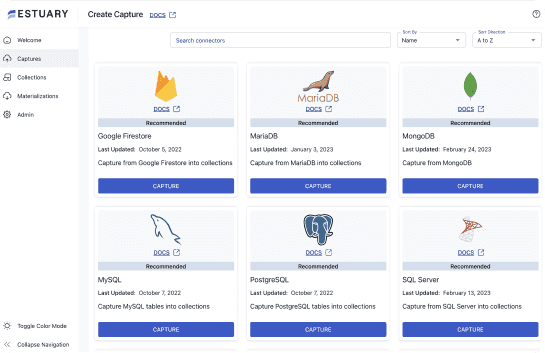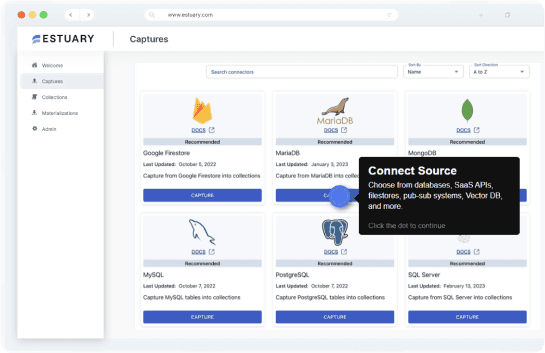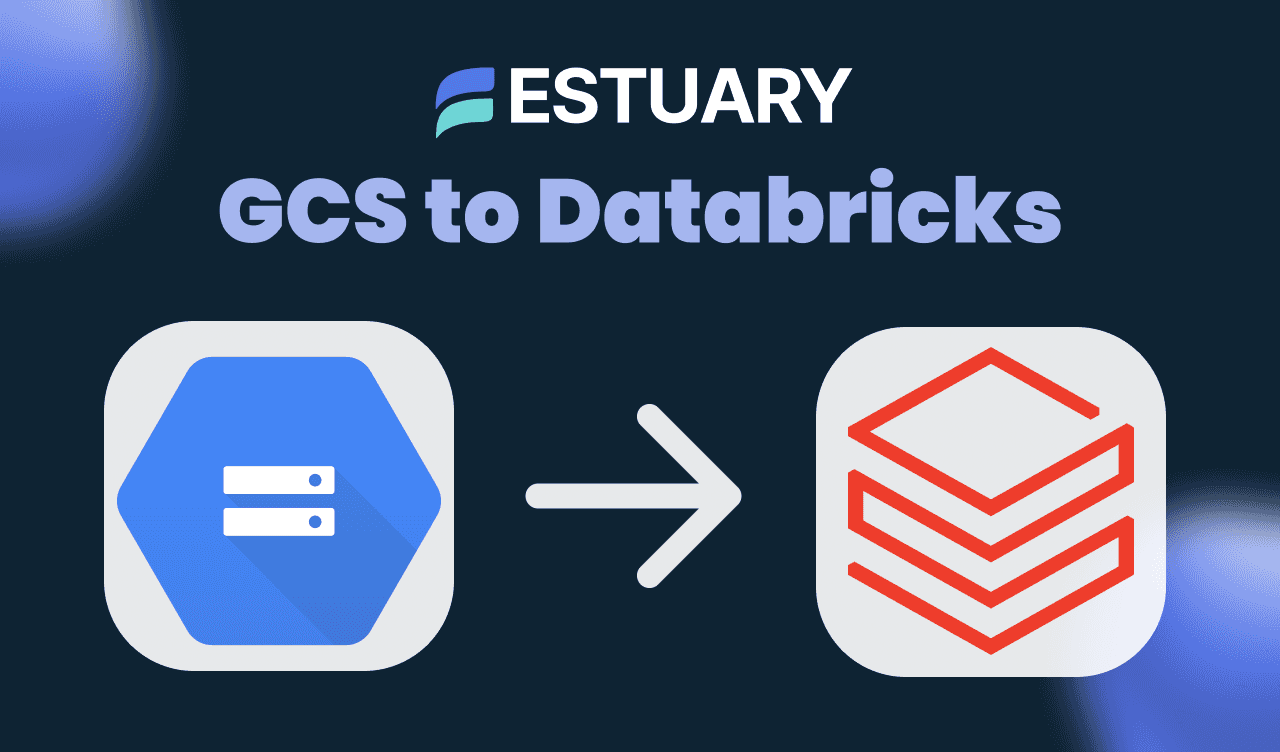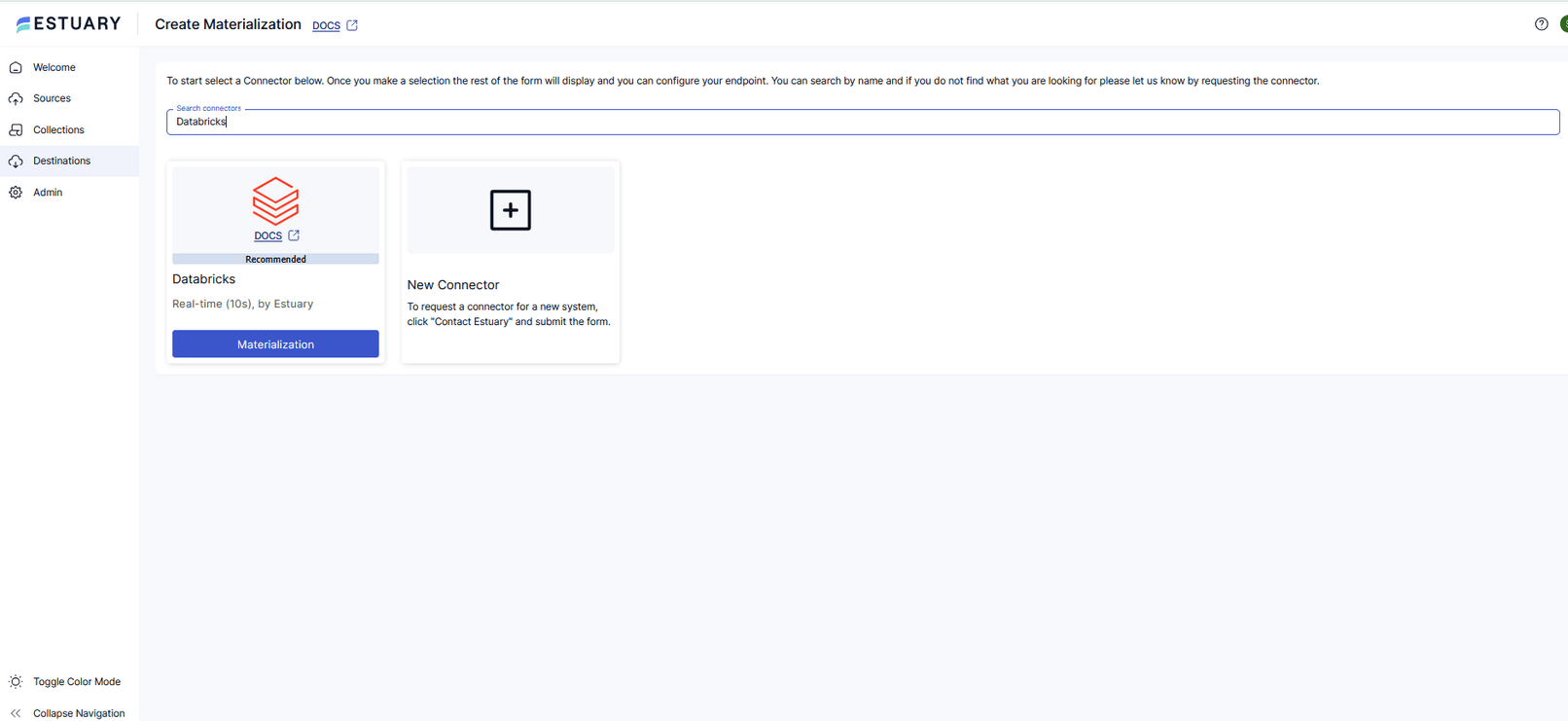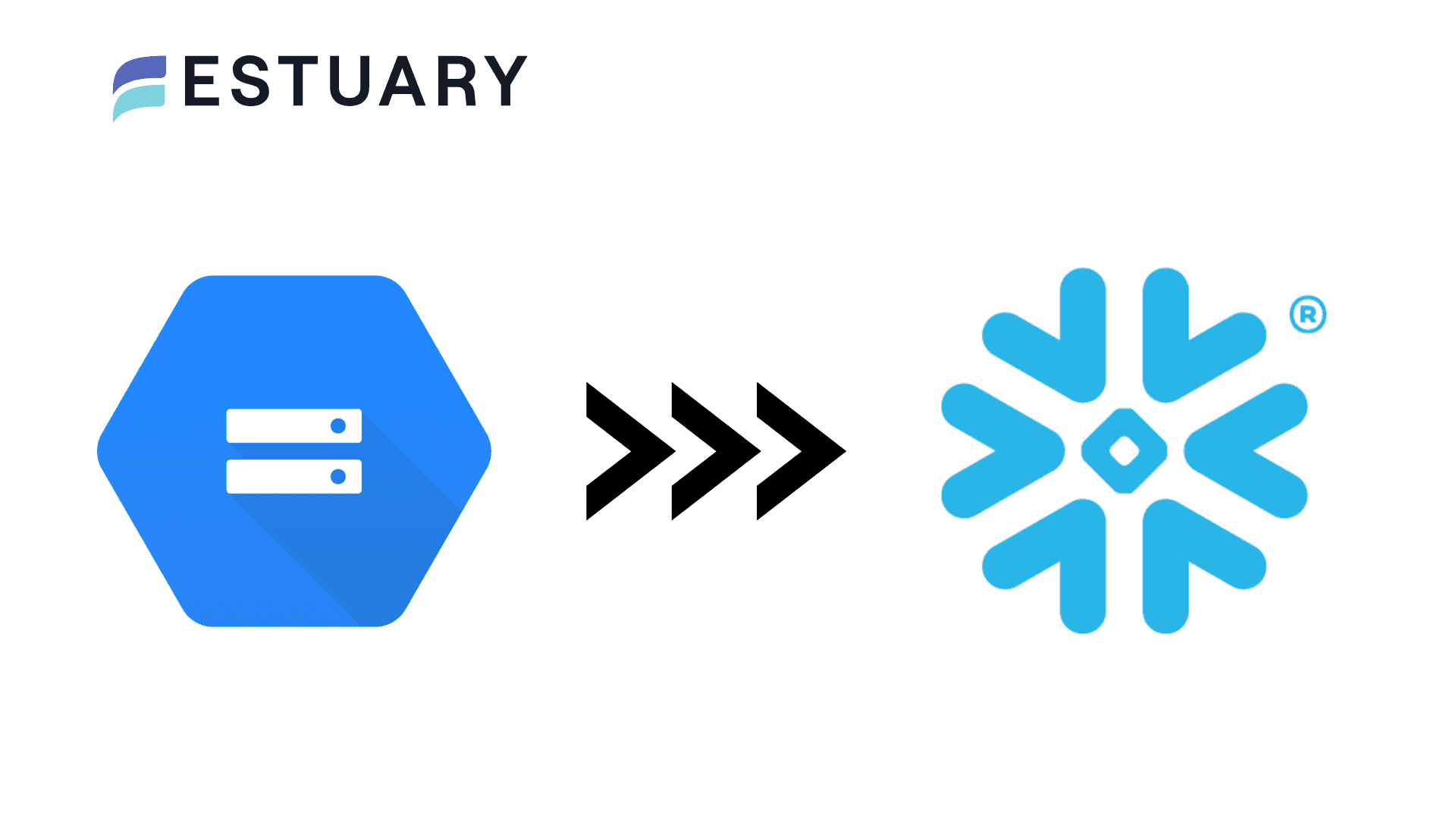
Introduction: Why Connect GCS to Databricks in the First Place?
In modern data architectures, Google Cloud Storage (GCS) is often used as a staging ground for raw and semi-structured data. It stores logs, exports, partner feeds, and outputs from upstream systems. Databricks, on the other hand, is widely adopted for analytics, machine learning, and AI workloads.
However, moving data from GCS to Databricks is not always straightforward. Many teams still rely on manual exports, scheduled batch jobs, or complex ETL pipelines that introduce unnecessary delays and operational overhead. Security concerns also arise when data is passed through third-party systems or custom-built loaders.
What if you could connect GCS to Databricks with minimal latency, full control over infrastructure, and no custom code?
This article explains how to build a secure, low-latency GCS to Databricks pipeline using Estuary Flow.
The Case for GCS and Databricks in Enterprise Architectures
Google Cloud Storage is a widely used object store for enterprises. It serves as a centralized location for landing data from internal systems, external partners, and third-party platforms. Whether the data arrives as CSV, JSON, Avro, or compressed files, GCS is often the first stop before anything can be analyzed or operationalized.
Databricks, powered by the Lakehouse architecture, is built for the next stage. It offers a unified platform for data warehousing, analytics, and machine learning. Teams use it to run SQL queries, train models, and deliver insights from structured and unstructured datasets.
This raises an important question.
How do you efficiently and securely move files from GCS into Databricks so that analysts, data scientists, and applications can act on the data without delay?
For many organizations, this connection is the missing piece in their data infrastructure. The right solution must be low-latency, reliable, and compliant with internal security standards. That is where Estuary Flow comes in.
Common Pitfalls in Traditional GCS to Databricks Workflows
Transferring data from Google Cloud Storage to Databricks may seem simple at first. But for most teams, it becomes a source of friction over time.
One common approach is to write scheduled scripts that pull files from GCS, load them into a staging table in Databricks, and apply transformations downstream. While this may work initially, it introduces several challenges:
- Latency. Scheduled jobs often run hourly or daily, which means insights are delayed and decision-making is reactive.
- Manual effort. Custom ETL code must be written, deployed, and maintained. When schemas change or data formats vary, these pipelines break.
- Lack of observability. Debugging file-level issues or data mismatches can be time-consuming, especially when dealing with compressed or nested formats.
- Security risks. Many tools require handing over GCS credentials or routing data through third-party infrastructure, creating compliance concerns.
In short, traditional methods often fail to meet the performance, reliability, and governance standards that modern enterprises require.
Meet Estuary Flow: A Streaming-Native, Secure, No-Code Platform
Estuary Flow is a real-time data movement platform that simplifies how organizations connect sources like Google Cloud Storage to destinations like Databricks. It provides built-in connectors, schema-aware pipelines, and automation features that reduce the time and effort required to build reliable integrations.
Flow allows you to create pipelines using a simple web interface or declarative configuration files. There is no need to manage orchestration, schedule batch jobs, or write custom transformation logic.
More importantly, Flow is built with security and scalability in mind. You can deploy it in a Bring Your Own Cloud (BYOC) model, ensuring that all data remains within your private infrastructure. This is ideal for enterprises with strict compliance requirements.
What if you could move data from GCS to Databricks with full control, near real-time delivery, and zero custom code?
That is exactly what Estuary Flow enables.
Understanding Latency: What Real-Time Means for GCS Pipelines
It is important to define what “real-time” means when working with file-based systems like Google Cloud Storage. Unlike databases or event streams, GCS does not emit changes the moment they happen. Instead, files must be discovered through polling.
Estuary Flow captures data from GCS using a default polling interval of five minutes. When a new or updated file is detected, it is immediately parsed, validated, and stored as structured documents in Flow’s internal collections. From there, updates are pushed to Databricks every ten seconds by default.
This results in pipelines with sub-minute latency after files are discovered.
While this is not true event-level streaming from GCS, it is a reasonably low-latency model for object storage. You do not need to build complex notification systems or schedule ETL jobs. Estuary handles ingestion, transformation, and delivery with minimal configuration.
If it’s worth the effort to set up and maintain a real-time message system to track GCS events, you can also configure Google Pub/Sub to capture Cloud Storage changes. You can then use Estuary’s Pub/Sub capture connector to send this data along wherever you like—but that’s another tutorial.
For most use cases, the GCS connector is more than fast enough to enable timely analytics, reporting, and automation in Databricks.
Security and Control: Estuary’s BYOC Deployment for Enterprises
Security is a non-negotiable requirement when dealing with sensitive or regulated data. Estuary Flow was built with this in mind.
With Estuary’s Bring Your Own Cloud (BYOC) deployment model, you run the Flow runtime inside your own infrastructure. Your data never leaves your cloud environment. There is no need to route it through third-party servers or expose credentials to external systems.
This architecture gives you complete control over data access, network boundaries, and compliance. It integrates with your existing security practices, including:
- VPC peering or private networking
- Role-based access controls through IAM or service principals
- Encrypted credentials using tools like SOPS
- SSH tunneling or PrivateLink for secure endpoint connectivity
You can even configure Flow to impersonate specific service accounts when accessing GCS buckets, further limiting privilege exposure.
With Estuary, your data pipelines are not just efficient. They are secure, auditable, and fully aligned with enterprise-grade governance standards.
Step-by-Step Tutorial: Build a GCS to Databricks Pipeline in Minutes
Creating a pipeline from Google Cloud Storage to Databricks using Estuary Flow requires just a few guided steps. You do not need to write any code or manage infrastructure. Here is how it works.
Step 1: Configure the GCS Source Connector
- In the Estuary Flow web app, create a new Capture and choose Google Cloud Storage as the connector.
- Enter the bucket name that contains your files.
- (Optional) Specify a prefix if you want to limit the scope to a folder or path.
- Upload your Google Service Account JSON key or use impersonation if preferred.
- Configure the parser settings based on your file format:
- Format: Auto, CSV, JSON, Avro, etc.
- Compression: Auto, gzip, zip, zstd, or none
- Advanced options: headers, delimiters, encoding
- Save and Publish your capture.
Flow will automatically validate your configuration and create a collection schema based on the file structure, then begin polling GCS for new files.
Step 2: Set Up the Databricks Materialization
- Create a new Materialization and choose Databricks as the destination connector.
- Provide the following connection details:
- Address of your SQL Warehouse
- HTTP Path
- Catalog name and Schema name
- Personal Access Token from Databricks (can be user or service principal)
- (Optional) Enable delta updates to reduce warehouse load and update costs if your data has unique keys.
Step 3: Bind the Source to the Destination
- In the bindings section, select the GCS collection as the source.
- Assign it to the appropriate table and schema in Databricks.
- Click Publish to deploy the pipeline
Once deployed, Flow uses the schema from your source collection to automatically map fields to Databricks tables. Flow will stream structured data into your Databricks tables every ten seconds after discovery.
You can monitor pipeline activity, view logs, and configure sync behavior directly in the Estuary UI.
For detailed configuration options, you can refer to the official documentation for each connector:
Advanced Configuration for Complex Enterprise Workflows
Estuary Flow offers powerful features that let you fine-tune your GCS to Databricks pipeline beyond the defaults. These options are especially useful for handling complex datasets, ensuring resilience, and meeting compliance requirements.
Custom File Parsing and Filtering
If your GCS bucket contains varied or non-standard files, you can adjust the parser configuration to handle:
- File format (CSV, JSON, Avro, Protobuf, W3C logs, Parquet)
- Compression type (gzip, zip, zstd, none)
- Column headers, quote characters, line endings, and delimiters for CSV files
- Regex-based filtering to capture only matching filenames (for example,
.*/daily-logs-.*\.json)
IAM Impersonation Support
If your GCP setup includes one service account impersonating another, Estuary supports secure service account impersonation using encrypted credentials. This makes access control simpler while keeping permissions scoped.
Sync Schedule and Delta Updates
- Adjust how frequently Flow syncs new data with the destination. Use a sync frequency of
0sfor the fastest possible real-time data, or batch your data in minutes, hours, or days. - Enable delta updates in Databricks to reduce the number of read operations and lower compute usage when working with large or append-only datasets.
These options give you control and flexibility without introducing complexity. Whether you need to capture large volumes of structured files, enforce security policies, or maintain high performance, Estuary Flow adapts to your requirements.
Enterprise Use Cases: Who Benefits from This Integration?
The ability to move structured files from Google Cloud Storage into Databricks with low latency and strong security opens up a wide range of enterprise scenarios. Here are a few common use cases where this pipeline delivers immediate value:
Retail and eCommerce
Retailers often store transactional data, product catalogs, or inventory logs as CSV or JSON files in GCS. Estuary Flow helps bring that data into Databricks for real-time demand forecasting, fraud detection, and pricing optimization.
Marketing and Advertising
Marketing teams can sync campaign logs, attribution files, or third-party analytics exports from GCS to Databricks for dashboarding, audience segmentation, or performance modeling. Updates flow through continuously, so reporting is always current.
Finance and Compliance
Financial institutions export audit logs, reconciliation records, and trade data to cloud storage. Estuary enables secure delivery of that data to Databricks for anomaly detection, reporting, and compliance checks, while ensuring data stays within governed infrastructure.
Healthcare and Life Sciences
In regulated industries like healthcare, patient data or clinical logs are often stored in secure GCS environments. Estuary’s BYOC deployment and support for fine-grained IAM roles allow these teams to safely sync sensitive data to Databricks for research or operational analytics.
IoT and Edge Workloads
Devices and sensors often batch their output as log files uploaded to GCS. Flow captures and transforms this data for real-time ingestion into Databricks, enabling teams to act quickly on signals from the physical world.
These are just a few of the many use cases where combining the flexibility of GCS with the power of Databricks through Estuary Flow helps teams move faster, stay compliant, and build smarter systems.
Conclusion: Transform Your GCS Buckets into Lakehouse Engines
Moving data from Google Cloud Storage to Databricks no longer needs to involve custom scripts, batch jobs, or manual workflows. With Estuary Flow, you can create secure, low-latency pipelines that connect file-based cloud storage to your Databricks lakehouse in just a few steps.
You gain the ability to:
- Detect and ingest new files with minimal delay
- Push structured updates into Databricks every few seconds
- Maintain complete control over security and compliance through BYOC deployment
- Eliminate fragile ETL infrastructure without sacrificing flexibility
If you are looking to modernize your GCS to Databricks integration, Estuary Flow offers the fastest and most secure way to get started.
Ready to try it for yourself? Sign up for free or talk to our team to build your first pipeline in minutes.

About the author
Team Estuary is a group of engineers, product experts, and data strategists building the future of real-time and batch data integration. We write to share technical insights, industry trends, and practical guides.

